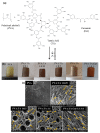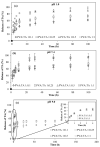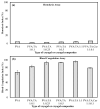Poly(vinyl alcohol)-tannic Acid Cryogel Matrix as Antioxidant and Antibacterial Material
- PMID: 35012093
- PMCID: PMC8747331
- DOI: 10.3390/polym14010070
Poly(vinyl alcohol)-tannic Acid Cryogel Matrix as Antioxidant and Antibacterial Material
Abstract
The biocompatible, viscoelastic properties of poly(vinyl alcohol) (PVA) in combination with the antimicrobial and antioxidant natural polyphenolic, tannic acid (TA), and the natural flavonoid and antioxidant curcumin (Cur), were used in the preparation of PVA:TA and PVA:TA:Cur cryogel composites using cryotropic gelation to combine the individually beneficial properties. The effect of TA content on the antioxidant and antimicrobial activities of PVA:TA cryogel composites and the antioxidant activities of PVA:TA:Cur cryogel composites was determined using Trolox equivalent antioxidant capacity (TEAC) and total phenol content (TPC) assays, and were compared. The PVA:TA:Cur cryogel composite showed the highest antioxidant activity, with a TEAC value of 2.10 ± 0.24 and a TPC value of 293 ± 12.00. The antibacterial capacity of the PVA:TA and PVA:TA:Cur 1:1:0.1 cryogel composites was examined against two different species of bacteria, E. coli and S. aureus. It was found that the minimum inhibition concentration (MIC) value of the PVA:TA:Cur 1:1:0.1 cryogel composites varied between 5 and 10 mg/mL based on the type of microorganism, and the minimum bactericidal concentration (MBC) value was 20 mg/mL irrespective of the type of microorganism. Furthermore, the hemocompatibility of the PVA:TA cryogel composites was evaluated by examining their hemolytic and coagulation behaviors. PVA:TA 1:1 cryogels with a value of 95.7% revealed the highest blood clotting index value amongst all of the synthesized cryogels, signifying the potential for blood contacting applications. The release of TA and Cur from the cryogel composites was quantified at different pH conditions, i.e., 1.0, 7.4, and 9.0, and additionally in ethanol (EtOH) and an ethanol-water (EtOH:Wat) mixture. The solution released from the PVA:TA cryogels in PBS was tested for inhibition capability against α-glucosidase (E.C. 3.2.1.20). Concentration-dependent enzyme inhibition was observed, and 70 µL of 83 µg/mL PVA:TA (1:1) cryogel in PBS inhibited α-glucosidase enzyme solution of 0.03 unit/mL in 70 µL by 81.75 ± 0.96%.
Keywords: antibacterial; antioxidant; cryogel; phenolic compound; polyvinyl alcohol.
Conflict of interest statement
The authors declare no conflict of interest.
Figures







References
-
- Lozinsky V.I. Polymeric Cryogels. Springer International Publishing; Cham, Switzerland: 2014. A Brief History of Polymeric Cryogels; pp. 1–48.
-
- Zhang Q., Hu X.M., Wu M.Y., Wang M.M., Zhao Y.Y., Li T.T. Synthesis and performance characterization of poly(vinyl alcohol)-xanthan gum composite hydrogel. React. Funct. Polym. 2019;136:34–43. doi: 10.1016/j.reactfunctpolym.2019.01.002. - DOI
-
- Bajpai A.K., Vishwakarma A., Bajpai J. Synthesis and characterization of amoxicillin loaded poly (vinyl alcohol)-g-poly (acrylamide) (PVA-g-PAM) hydrogels and study of swelling triggered release of antibiotic drug. Polym. Bull. 2019;76:3269–3295. doi: 10.1007/s00289-018-2536-2. - DOI
-
- Caló E., Barros J., Ballamy L., Khutoryanskiy V.V. Poly(vinyl alcohol)–Gantrez® AN cryogels for wound care applications. RSC Adv. 2016;6:105487–105494. doi: 10.1039/C6RA24573K. - DOI
Grants and funding
LinkOut - more resources
Full Text Sources
Other Literature Sources
Miscellaneous

